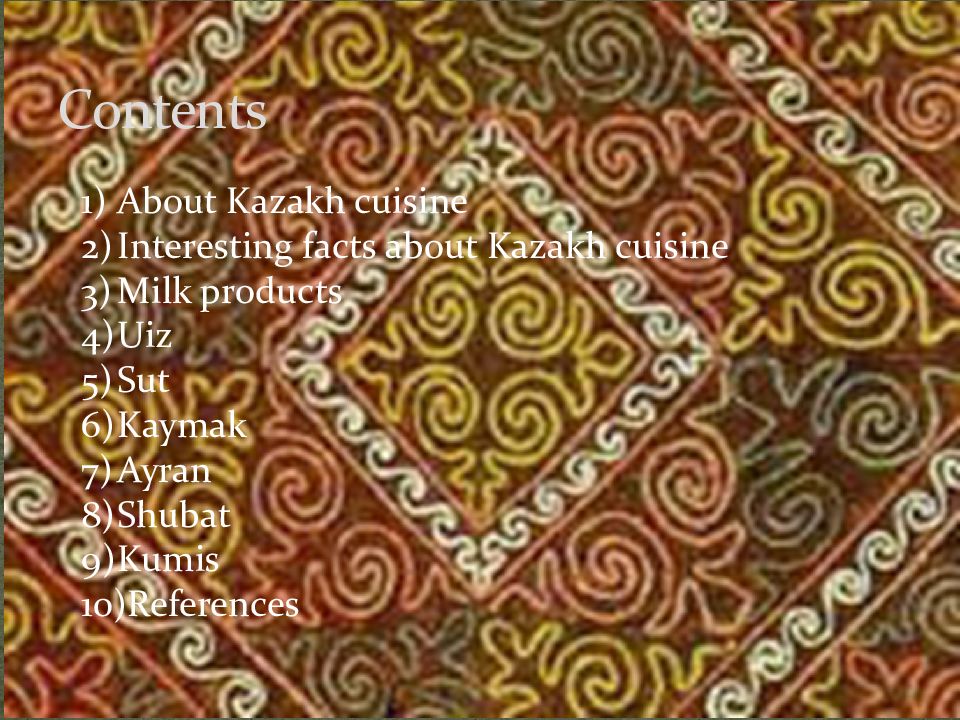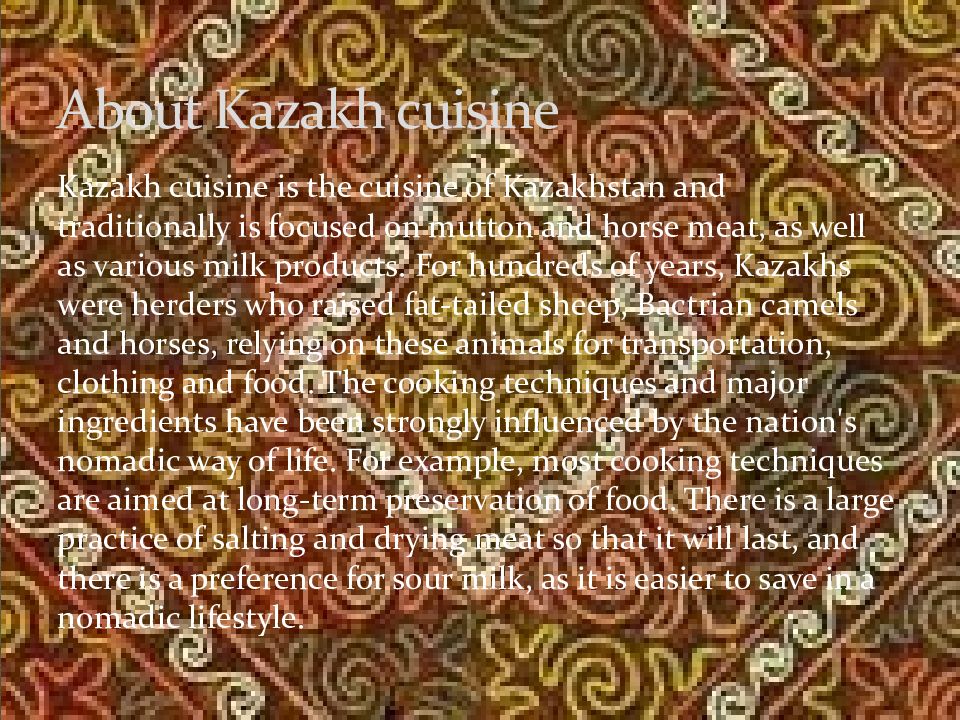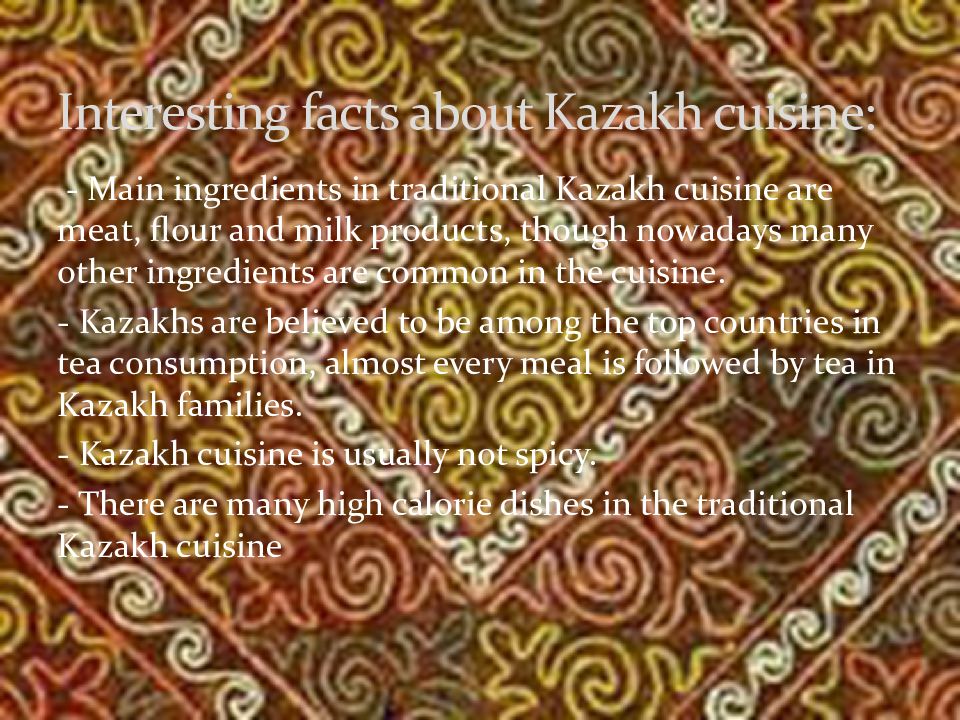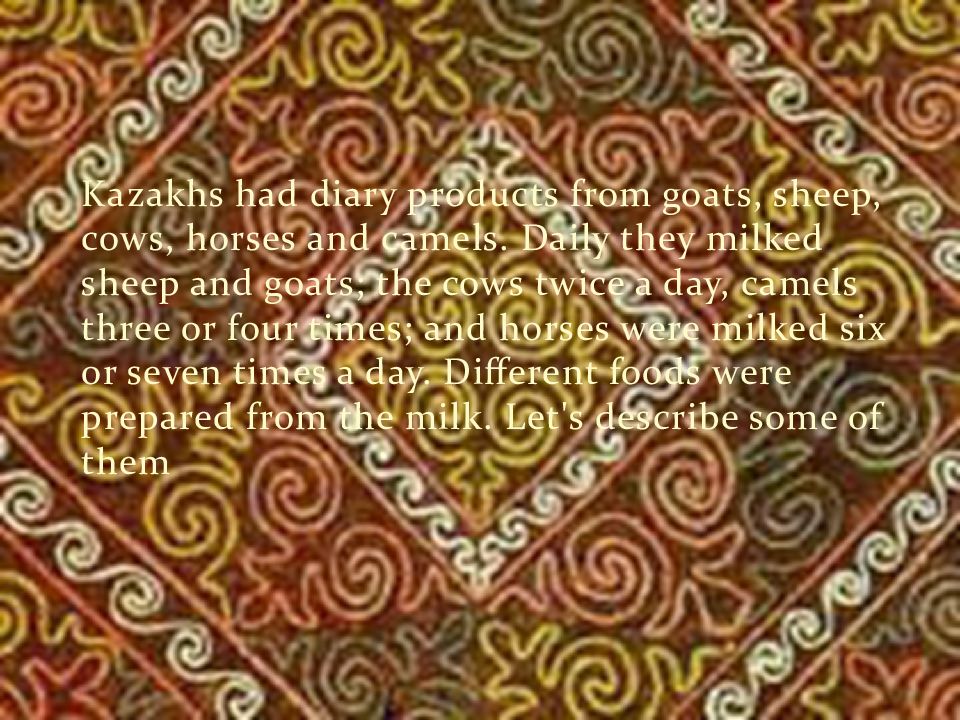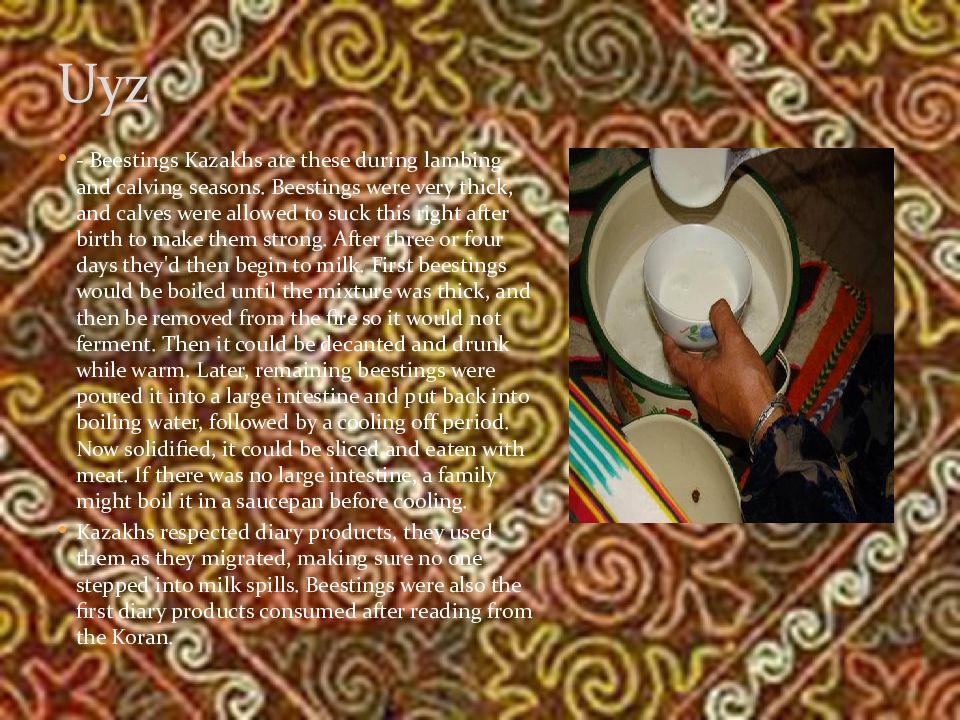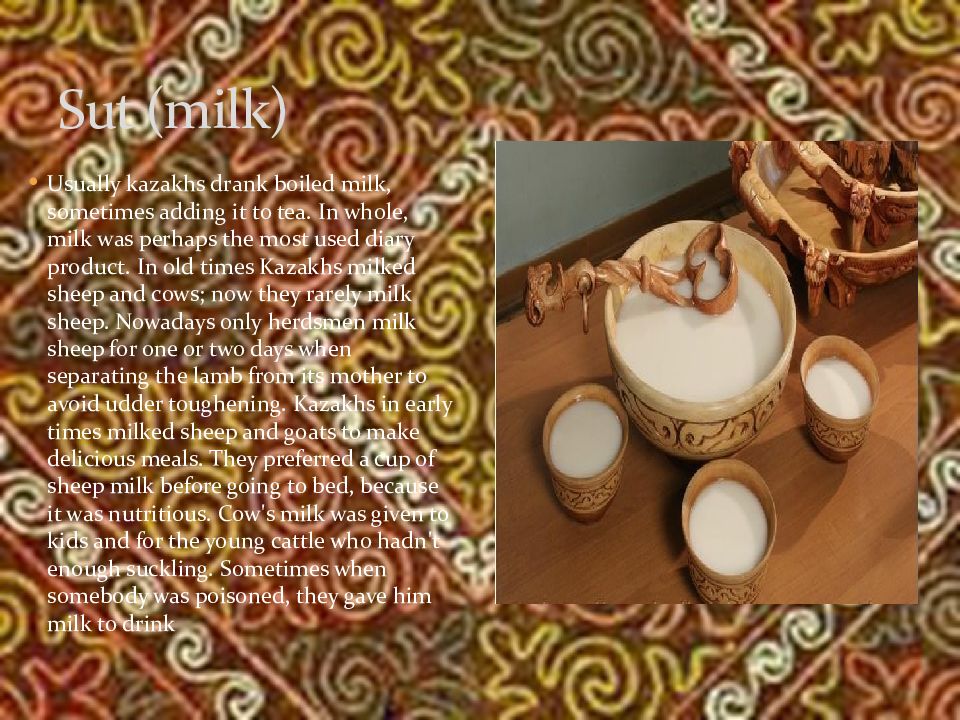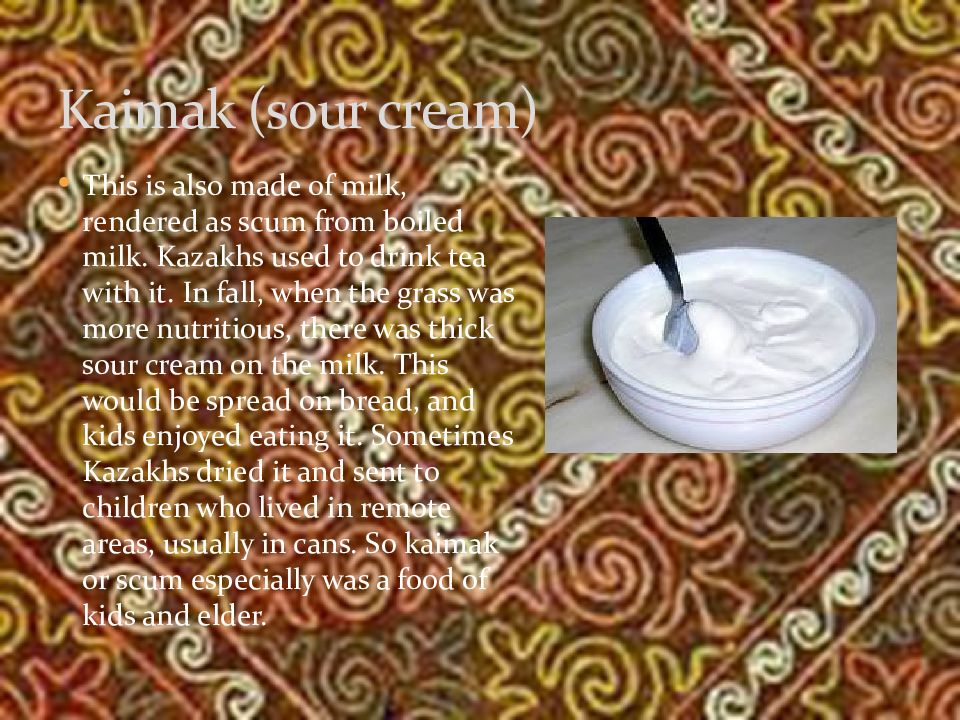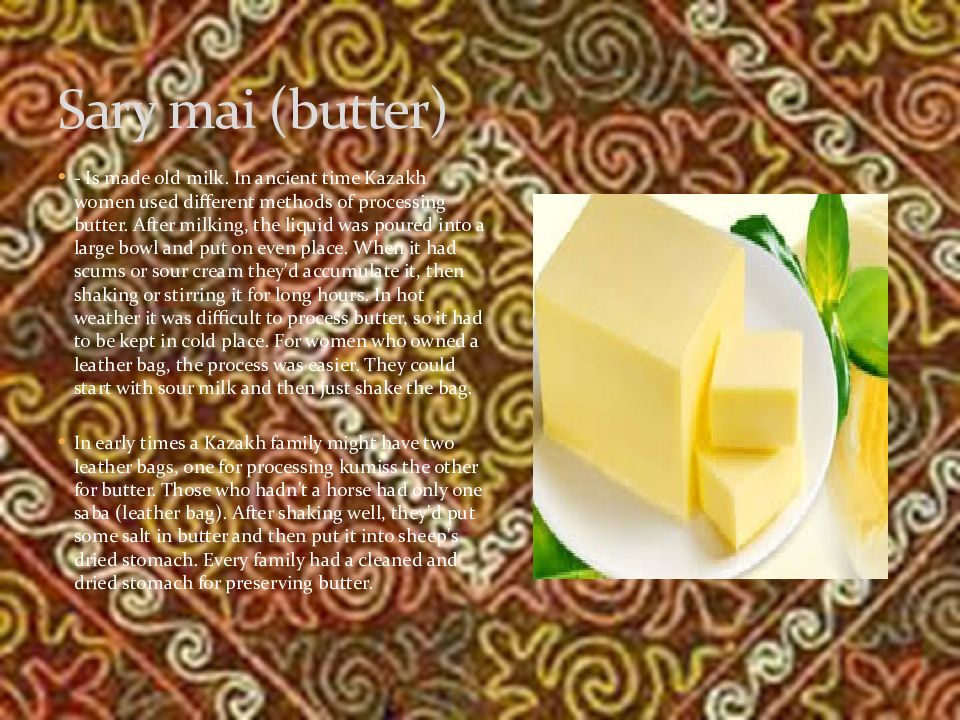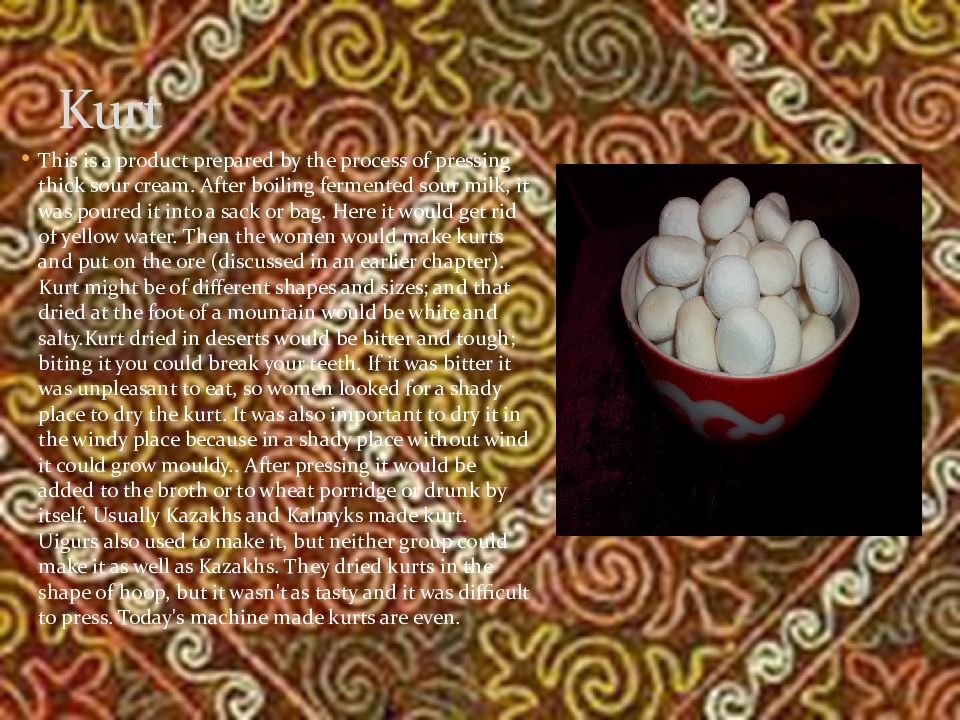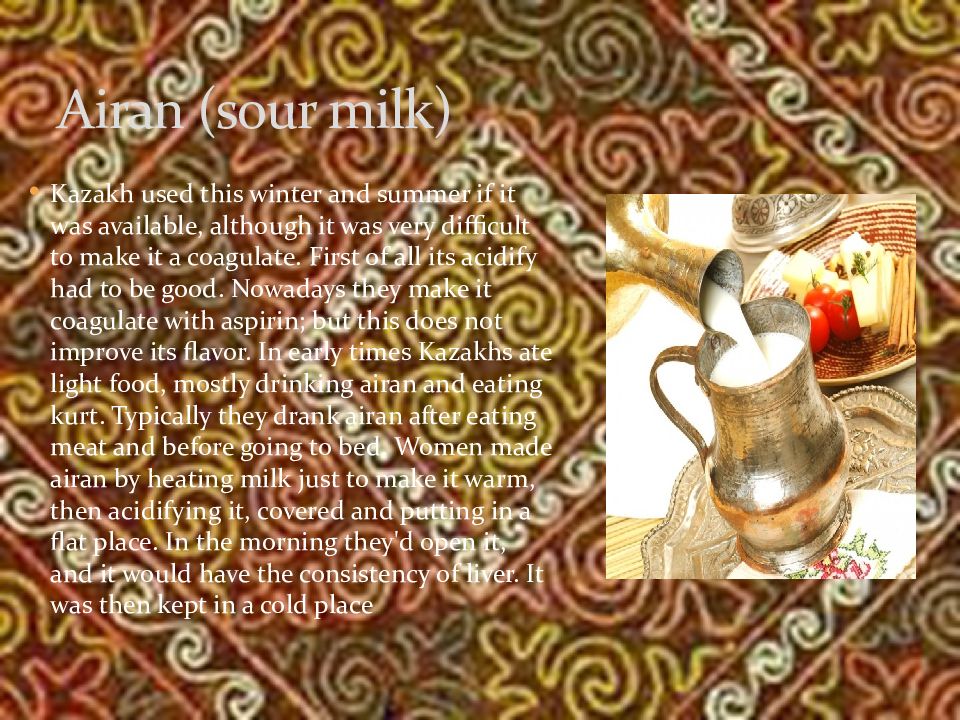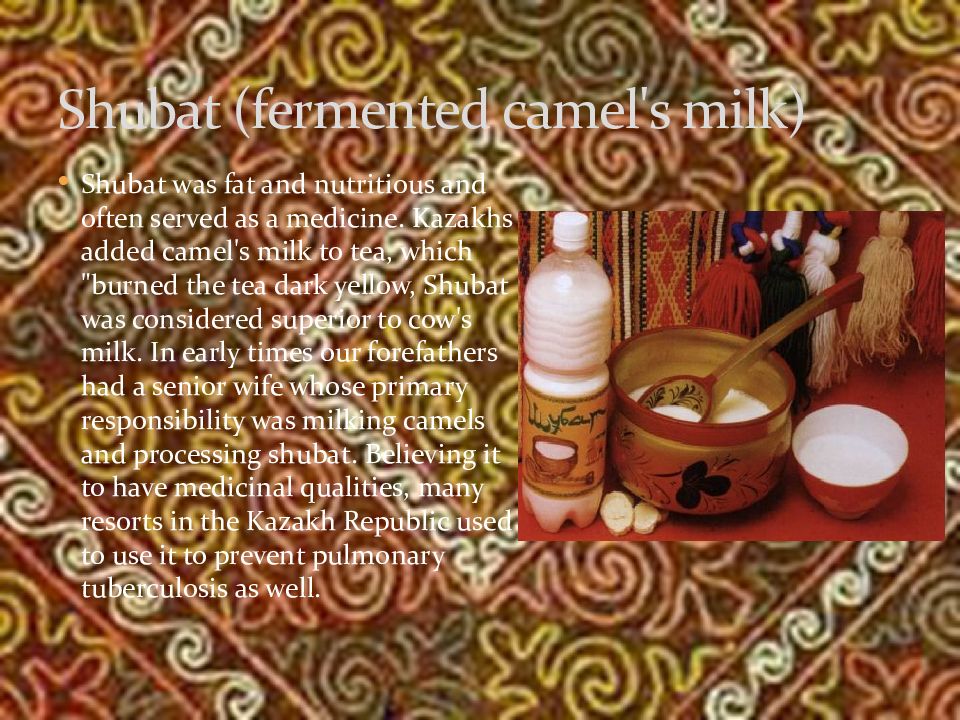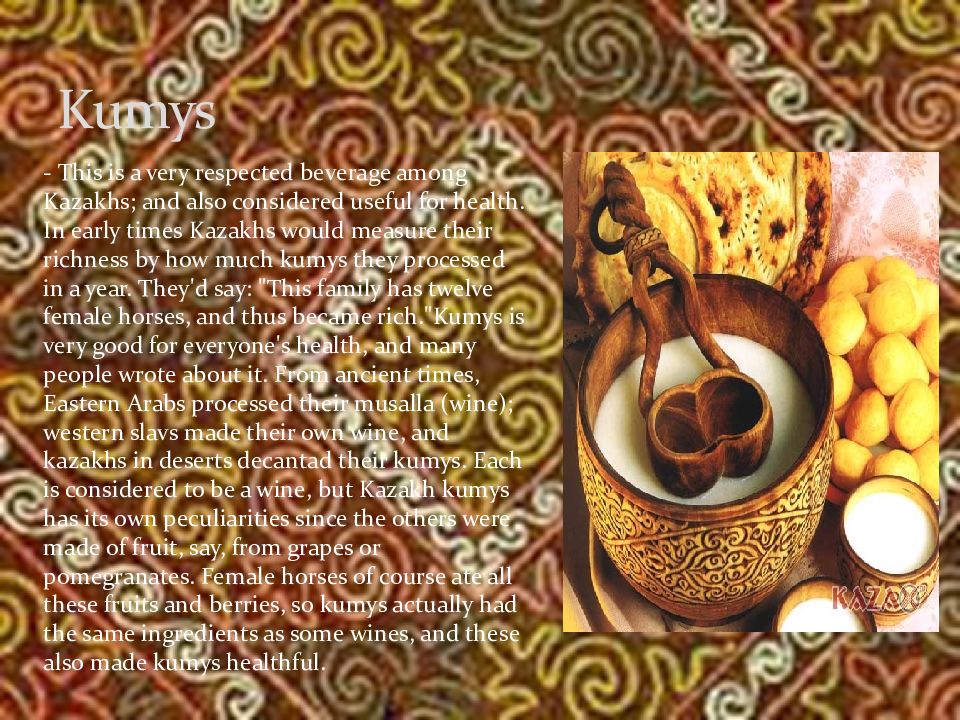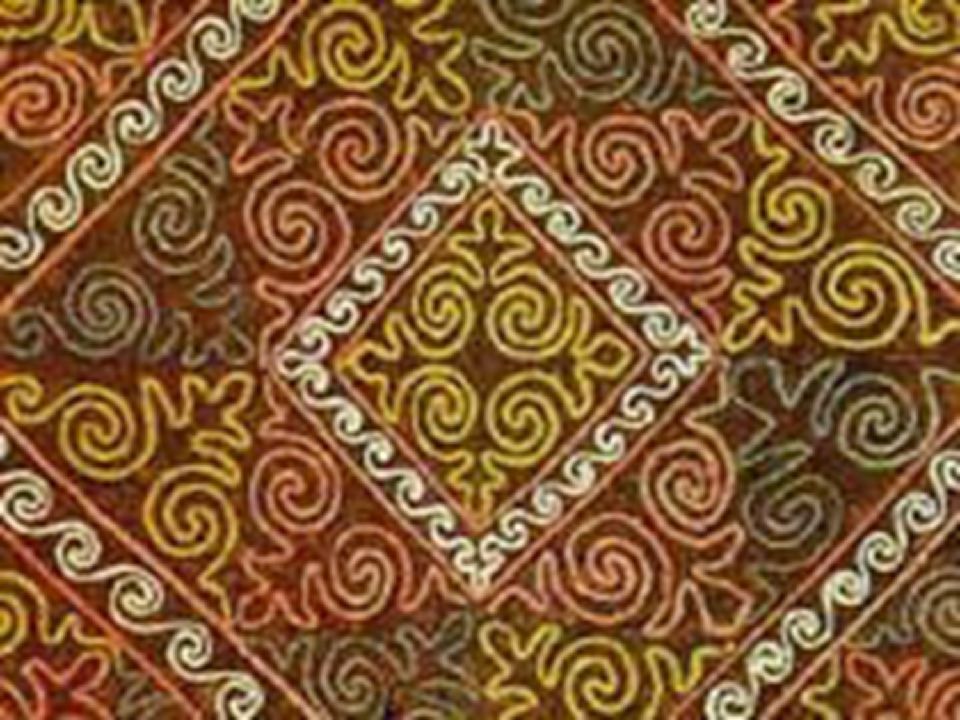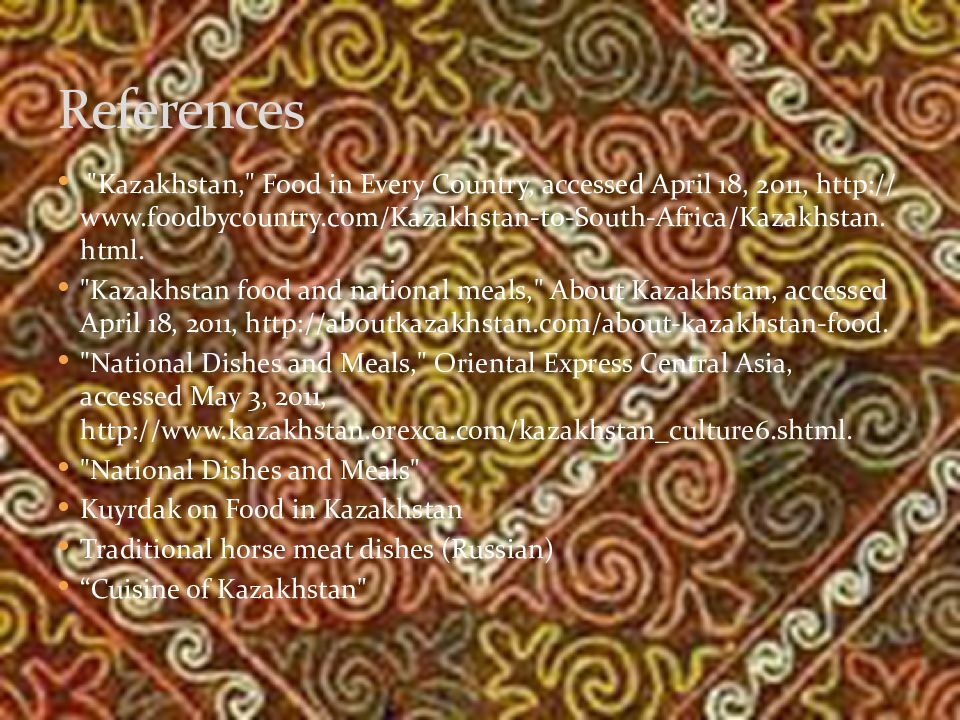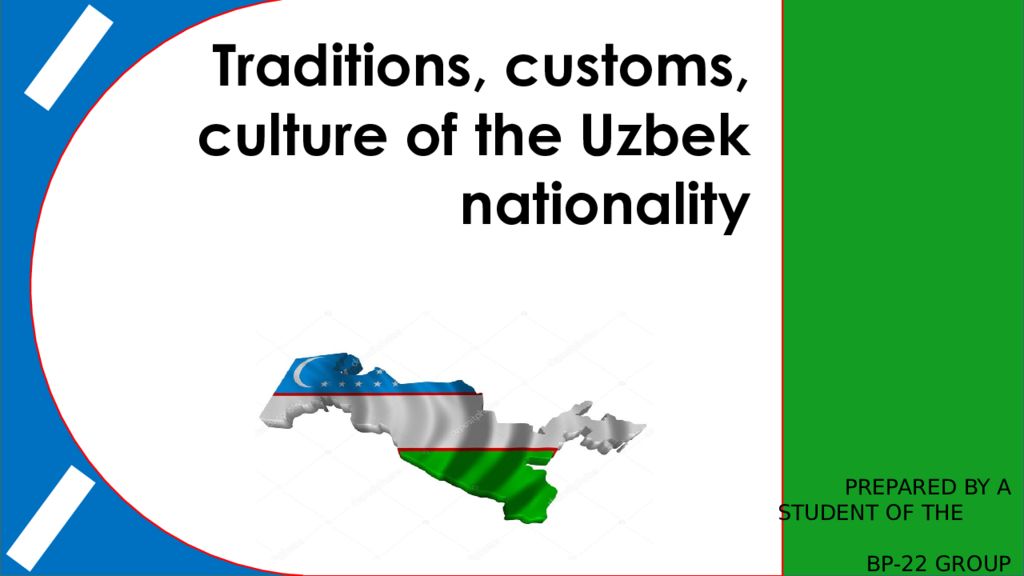Первый слайд презентации: KAZAKH NATIONAL DISHES
MILK PRODUCTS Prepared by: Tabuldiyeva Aida Group: STR-11 KAZAKH NATIONAL DISHES West Kazakhstan Agrarian-Technical University by named Zhangir Khan Uralsk 2014
Слайд 2: Contents
About Kazakh cuisine Interesting facts about Kazakh cuisine Milk products Uiz Sut Kaymak Ayran Shubat Kumis References
Слайд 3: About Kazakh cuisine
Kazakh cuisine is the cuisine of Kazakhstan and traditionally is focused on mutton and horse meat, as well as various milk products. For hundreds of years, Kazakhs were herders who raised fat-tailed sheep, Bactrian camels and horses, relying on these animals for transportation, clothing and food. The cooking techniques and major ingredients have been strongly influenced by the nation's nomadic way of life. For example, most cooking techniques are aimed at long-term preservation of food. There is a large practice of salting and drying meat so that it will last, and there is a preference for sour milk, as it is easier to save in a nomadic lifestyle. About Kazakh cuisine
- Main ingredients in traditional Kazakh cuisine are meat, flour and milk products, though nowadays many other ingredients are common in the cuisine. - Kazakhs are believed to be among the top countries in tea consumption, almost every meal is followed by tea in Kazakh families. - Kazakh cuisine is usually not spicy. - There are many high calorie dishes in the traditional Kazakh cuisine Interesting facts about Kazakh cuisine :
Слайд 5
Kazakhs had diary products from goats, sheep, cows, horses and camels. Daily they milked sheep and goats; the cows twice a day, camels three or four times; and horses were milked six or seven times a day. Different foods were prepared from the milk. Let's describe some of them
Слайд 6: Uyz
- Beestings Kazakhs ate these during lambing and calving seasons. Beestings were very thick, and calves were allowed to suck this right after birth to make them strong. After three or four days they'd then begin to milk. First beestings would be boiled until the mixture was thick, and then be removed from the fire so it would not ferment. Then it could be decanted and drunk while warm. Later, remaining beestings were poured it into a large intestine and put back into boiling water, followed by a cooling off period. Now solidified, it could be sliced and eaten with meat. If there was no large intestine, a family might boil it in a saucepan before cooling. Kazakhs respected diary products, they used them as they migrated, making sure no one stepped into milk spills. Beestings were also the first diary products consumed after reading from the Koran. Uyz
Слайд 7: Sut (milk)
Usually kazakhs drank boiled milk, sometimes adding it to tea. In whole, milk was perhaps the most used diary product. In old times Kazakhs milked sheep and cows; now they rarely milk sheep. Nowadays only herdsmen milk sheep for one or two days when separating the lamb from its mother to avoid udder toughening. Kazakhs in early times milked sheep and goats to make delicious meals. They preferred a cup of sheep milk before going to bed, because it was nutritious. Cow's milk was given to kids and for the young cattle who hadn't enough suckling. Sometimes when somebody was poisoned, they gave him milk to drink Sut (milk)
Слайд 8: Kaimak (sour cream )
This is also made of milk, rendered as scum from boiled milk. Kazakhs used to drink tea with it. In fall, when the grass was more nutritious, there was thick sour cream on the milk. This would be spread on bread, and kids enjoyed eating it. Sometimes Kazakhs dried it and sent to children who lived in remote areas, usually in cans. So kaimak or scum especially was a food of kids and elder. Kaimak (sour cream )
Слайд 9: Sary mai (butter)
- Is made old milk. In ancient time Kazakh women used different methods of processing butter. After milking, the liquid was poured into a large bowl and put on even place. When it had scums or sour cream they'd accumulate it, then shaking or stirring it for long hours. In hot weather it was difficult to process butter, so it had to be kept in cold place. For women who owned a leather bag, the process was easier. They could start with sour milk and then just shake the bag. In early times a Kazakh family might have two leather bags, one for processing kumiss the other for butter. Those who hadn't a horse had only one saba (leather bag). After shaking well, they'd put some salt in butter and then put it into sheep's dried stomach. Every family had a cleaned and dried stomach for preserving butter. Sary mai (butter)
Слайд 10: Kurt
This is a product prepared by the process of pressing thick sour cream. After boiling fermented sour milk, it was poured it into a sack or bag. Here it would get rid of yellow water. Then the women would make kurts and put on the ore (discussed in an earlier chapter). Kurt might be of different shapes and sizes; and that dried at the foot of a mountain would be white and salty.Kurt dried in deserts would be bitter and tough; biting it you could break your teeth. If it was bitter it was unpleasant to eat, so women looked for a shady place to dry the kurt. It was also important to dry it in the windy place because in a shady place without wind it could grow mouldy.. After pressing it would be added to the broth or to wheat porridge or drunk by itself. Usually Kazakhs and Kalmyks made kurt. Uigurs also used to make it, but neither group could make it as well as Kazakhs. They dried kurts in the shape of hoop, but it wasn't as tasty and it was difficult to press. Today's machine made kurts are even. Kurt
Слайд 11: Airan (sour milk )
Kazakh used this winter and summer if it was available, although it was very difficult to make it a coagulate. First of all its acidify had to be good. Nowadays they make it coagulate with aspirin; but this does not improve its flavor. In early times Kazakhs ate light food, mostly drinking airan and eating kurt. Typically they drank airan after eating meat and before going to bed. Women made airan by heating milk just to make it warm, then acidifying it, covered and putting in a flat place. In the morning they'd open it, and it would have the consistency of liver. It was then kept in a cold place Airan (sour milk )
Слайд 12: Shubat (fermented camel's milk)
Shubat was fat and nutritious and often served as a medicine. Kazakhs added camel's milk to tea, which "burned the tea dark yellow, Shubat was considered superior to cow's milk. In early times our forefathers had a senior wife whose primary responsibility was milking camels and processing shubat. Believing it to have medicinal qualities, many resorts in the Kazakh Republic used to use it to prevent pulmonary tuberculosis as well. Shubat (fermented camel's milk)
Слайд 13: Kumys
- This is a very respected beverage among Kazakhs; and also considered useful for health. In early times Kazakhs would measure their richness by how much kumys they processed in a year. They'd say: "This family has twelve female horses, and thus became rich." Kumys is very good for everyone's health, and many people wrote about it. From ancient times, Eastern Arabs processed their musalla (wine); western slavs made their own wine, and kazakhs in deserts decantad their kumys. Each is considered to be a wine, but Kazakh kumys has its own peculiarities since the others were made of fruit, say, from grapes or pomegranates. Female horses of course ate all these fruits and berries, so kumys actually had the same ingredients as some wines, and these also made kumys healthful.
Последний слайд презентации: KAZAKH NATIONAL DISHES: References
"Kazakhstan," Food in Every Country, accessed April 18, 2011, http://www.foodbycountry.com/Kazakhstan-to-South-Africa/Kazakhstan.html. " Kazakhstan food and national meals," About Kazakhstan, accessed April 18, 2011, http://aboutkazakhstan.com/about-kazakhstan-food. " National Dishes and Meals," Oriental Express Central Asia, accessed May 3, 2011, http://www.kazakhstan.orexca.com/kazakhstan_culture6.shtml. " National Dishes and Meals" Kuyrdak on Food in Kazakhstan Traditional horse meat dishes (Russian) “ Cuisine of Kazakhstan " References

